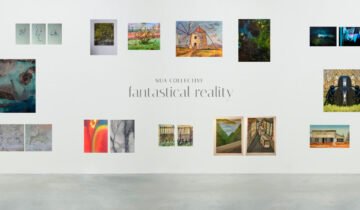By Eamonn B. Shanahan – click here to discover Eamonn’s work.
How Non-Traditional Venues Are Changing the Way We Experience Art
Art has long been housed in the pristine, white walls of galleries, elevated as an intellectual pursuit, often out of reach for everyday audiences. The traditional gallery space, while essential and still required, can be intimidating. Whether due to perceived exclusivity, financial inaccessibility, or the overwhelming formality of the environment, these spaces often deter potential viewers, especially when it comes to more concept-driven works. But as our relationship with art continues to evolve, so too do the spaces in which we encounter it. Increasingly, non-traditional venues—cafes, bars, libraries, bookstores, and multi-purpose event spaces—are becoming home to exhibitions, creating a more accessible, welcoming entry point for art lovers and the uninitiated alike.
The Problems with Traditional Galleries
Historically, galleries have catered to a specific crowd: the collectors, the critics, the art aficionados. These spaces, often intentionally minimalist and stark, are designed to focus attention solely on the art. However, the downside is that they can also feel cold and uninviting. For many, walking into a gallery can be an intimidating experience, often with unspoken codes of conduct similar to what was recently experienced by a child at Kaohsiung Museum of Art. The traditional gallery model also tends to isolate art from the broader public, operating in cities or affluent areas, where accessibility becomes an issue. This can result in a disengagement from art for those who may feel out of place or unwelcome in such environments.
The art world has long wrestled with the label of being “pretentious,” a perception that can alienate mass audiences. Conceptual art in particular—work that often asks viewers to question and engage further—can feel daunting or incomprehensible to someone who isn’t familiar with its language. For artists, especially those working in these conceptual areas, the challenge becomes not only to create meaningful work but to find ways to introduce and encourage public engagement with that work beyond the typical audience reach.
There’s also the issue of financial sustainability for galleries, especially in smaller communities with less footfall. In an era where gallery spaces struggle to sustain themselves purely on commissions from art sales, many have had to rethink their business models. The cost of renting a gallery space, staffing it, and marketing exhibitions can outweigh the profits, making it difficult for galleries to stay afloat. This struggle is not sustainable and has consequentially led to the closure of traditional/commercial gallery spaces, leaving artists and curators looking for alternatives.
Hybrid Spaces and the Benefits of Non-Traditional Art Spaces
This is where non-traditional venues step in. While this is not a new initiative, it should be nurtured and promoted as a valid space among the art community. This alternative approach to both the presentation and consumption of art in cafes, restaurants, bookstores, wine bars, etc., can provide environments where people feel more comfortable, where they go to relax, converse, and enjoy themselves. These spaces create a natural intersection between daily life and the art world, allowing patrons to stumble upon works they might not otherwise seek out.
By placing art in these settings, we blur the lines between where art should be displayed and how it can be encountered. When the art becomes a part of multi-functioning space, it allows patrons to engage with it without the pressure of a formal gallery visit. It’s less about making time for art, and more about art becoming an unexpected but welcome part of daily life.
Through our ‘Blackout’ tour, we’ve witnessed this setup firsthand. By showcasing work in non-traditional spaces, we have reached an audience that might otherwise overlook conceptual art. People of all ages and backgrounds have engaged with the work, not because they sought it out, but because it was presented in a space they were already comfortable in. The act of striking up a conversation about the work in these settings demystifies it, breaking down barriers that can often stop viewers from engaging with art. When the pressure is removed, people are free to explore the work on their own terms, elevating their personal interpretations through their unique life experiences and sparking conversational points with their companions based on the concepts presented.
Strengthening Communities Through Art
In smaller towns and local communities, the rise of chain stores and online shopping has led to a decline in local support for small businesses. However, what these large corporations cannot provide is the sense of human connection that comes from real-world events. Art exhibitions, particularly in non-traditional spaces, create opportunities for community gathering.
When local businesses collaborate with artists, they strengthen not only their own economic footing but also the fabric of the community itself. People are drawn to events that offer both an intellectual and social experience, and art provides a perfect medium for this kind of engagement. The community is invited to actively engage with the work, prompting conversations that build relationships and foster a sense of belonging. In return, businesses gain support not only from local patrons but also from the broader artistic community.
Mutual Benefits for Artists and Businesses
For the artist, non-traditional spaces offer more than just exposure; they offer a way to connect with a broader, more diverse audience. When people discover art in these settings, they do so in a way that feels organic, leading to more meaningful interactions with the work. As a result, artists have the opportunity to reach people who wouldn’t ordinarily walk into a gallery, expanding their network and deepening the connection to their audience and indeed the wider community.
For business owners, the benefits are equally compelling. Spaces that host exhibitions, artist talks, workshops, and tours see increased patronage, particularly on quieter days. A café that might otherwise struggle to draw in customers on a Tuesday afternoon can host an art exhibition, bringing in new faces and creating a buzz around their space. These exhibitions can be supplemented by ticket sales, artist talks, and merchandise, creating additional revenue streams that benefit both the business and the artist. The collaboration between art and business becomes mutually beneficial, where the business gains foot traffic and the artist gains visibility and a greater opportunity for art sales.
A New Marketing Opportunity
The collaboration between businesses and artists also opens up new marketing avenues. Traditional marketing strategies—especially in smaller communities—are becoming more expensive and less effective due to saturation. However, as an extension to their business model, hosting art exhibitions and related events offers a more indirect and favourable approach. By focusing on the human interest aspect of the exhibition, businesses are more likely to attract positive press coverage, drawing attention without relying on heavy-handed advertising. Exhibitions, talks, and events present themselves as community-centric stories that appeal to local media, offering a more organic marketing strategy that highlights the business’s commitment to culture and creativity.
The Future of Art Spaces
The future of art spaces lies in breaking down the walls—literally and figuratively—that have kept art sequestered from broader audiences. Non-traditional venues offer a way to bring art into the everyday, creating opportunities for people to engage with it in a way that feels natural and welcoming. By doing so, we not only democratise art but also create new economic opportunities for both artists and businesses while also injecting positivity into the local community.
When art is displayed outside an artist’s studio, it takes on new life. But this life can only grow if people of all demographics get to engage with it. Putting art in non-traditional spaces allows this to happen. The barriers that once stopped people from engaging with it begin to dissolve. The result is an education for those who don’t usually engage with artwork to see how it can inform and impact. The result is the presentation of art where everyone feels they have a right to experience art—no matter where they encounter it.
By Eamonn B. Shanahan – click here to discover Eamonn’s work.





 No products in the cart.
No products in the cart.